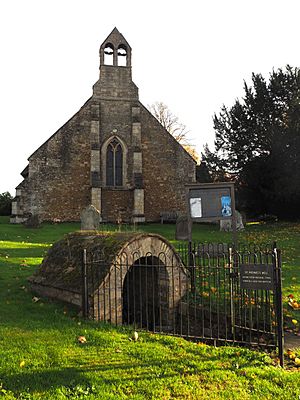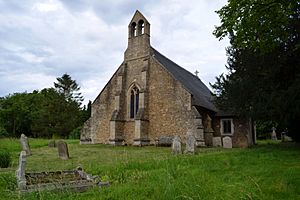St Michael's Church, Longstanton facts for kids
Quick facts for kids St Michael's Church, Longstanton |
|
|---|---|

West end of St Michael's Church, Longstanton, with the holy well in the foreground
|
|
| Lua error in Module:Location_map at line 420: attempt to index field 'wikibase' (a nil value). | |
| OS grid reference | TL 403 658 |
| Location | Longstanton, Cambridgeshire |
| Country | England |
| Denomination | Anglican |
| Website | Churches Conservation Trust |
| Architecture | |
| Functional status | Redundant |
| Heritage designation | Grade II* |
| Designated | 31 August 1962 |
| Architectural type | Church |
| Style | Gothic |
| Specifications | |
| Materials | Fieldstones with Barnack limestone dressings Roofs thatched and tiled |
St Michael's Church is a very old church in the village of Longstanton, Cambridgeshire, England. It's an Anglican church, which means it belongs to the Church of England. Today, it is a "redundant church," meaning it's no longer used for regular church services.
This church is very special! It is listed as a Grade II* listed building. This means it's an important historic building that needs to be protected. The Churches Conservation Trust takes care of it now. St Michael's Church is located at the south end of Longstanton village. Its unique design was even copied for other churches built in America, like the Church of St. James the Less in Philadelphia, Pennsylvania, and St. Thomas Church in New Windsor, New York. These churches were built in 1846 and were inspired by St Michael's Gothic Revival style.
Contents
History of St Michael's Church
Most of St Michael's Church was built a very long time ago, in the early 1200s. The west wall of the church was rebuilt in the 1400s. At that time, two large buttresses (strong supports for the wall) and a window were added to the west side. The south porch, which is like a covered entrance, was also built in the early 1400s.
In the 1800s, the chancel (the part of the church where the altar is) was actually used as a schoolroom! A curtain separated it from the nave (the main part of the church where people sit). In 1883, the old chancel was taken down. A new one was built the very next year, in 1884. The new chancel was carefully designed to look just like the original 1200s style.
A few years later, in 1889, the nave of the church was also repaired and improved. In 1958, St Michael's Church joined with another church in the area, All Saints. Sadly, in 1969, the two bells in the church's bell tower were stolen.
St Michael's Church stopped being used for regular services in 1973. In 1975, it was officially given to the Redundant Churches Fund. This group later became the Churches Conservation Trust, which cares for the church today. In 2000, the Trust repaired the church's special thatched roof.
Church Architecture
Outside the Church
The church is built from fieldstone, which are stones found in fields. It also has special Barnack limestone details. The roofs over the nave and the south porch are covered with reed thatch. The chancel roof is made of tiles. St Michael's is one of only two churches in Cambridgeshire that has a thatched roof. The other one is in a nearby village called Rampton.
The church's design includes a nave, which is the main part, and aisles on both the north and south sides. There is also a south porch and a chancel. On the west end of the roof, there is a double bellcote, which is a small structure holding two bells. On the west wall, you can see two large, four-stage buttresses. Between these buttresses is a window with two sections. Other windows in the church include three tall, narrow windows called lancet windows. These were added in the 1800s, likely replacing older ones that looked similar. The north wall has a doorway and some smooth, cut stones called ashlar, which suggest there might have been other openings there a long time ago.
Inside the Church
Inside St Michael's Church, you can see the arcades. These are rows of arches that separate the nave from the aisles. They were built in the 1200s. The arcades have four sections, called bays. The arches are supported by columns that switch between being round and octagonal (eight-sided).
In the chancel, there is a double piscina. A piscina is a stone basin used for washing sacred vessels during church services. This one has arches that cross over each other and is made from a soft, white stone called clunch. People say it looks similar to the piscina found in Jesus College Chapel in Cambridge.
Holy Well
In the churchyard, outside the church, there is a holy well. This well was repaired in the 1980s. In September 1986, it was "dressed" for the first time. Well dressing is a special tradition where wells are decorated with pictures made from natural materials like flowers and leaves.



